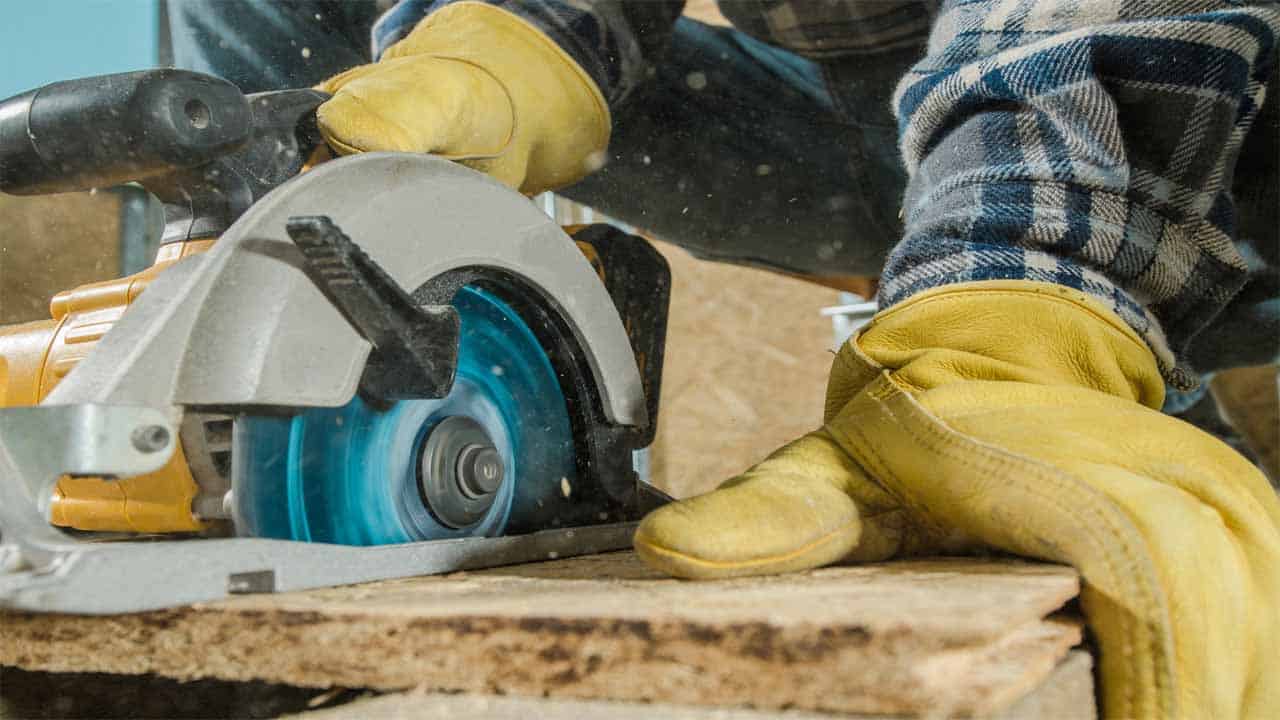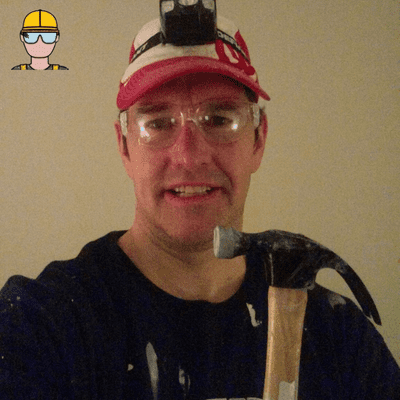How to Rip Narrow Boards With a Circular Saw? (5 Simple Steps)
TheToolGeeks.com is a participant in the Amazon Services LLC Associates Program and other affiliate advertising programs. We may earn from qualifying purchases. (Learn More).
Cutting with a circular saw can be challenging at the best of times, especially for beginners. They can easily slip and cause all kinds of issues for people who aren’t used to dealing with the power of the tool.
This difficulty becomes even worse when trying to deal with narrow boards which the circular saw isn’t necessarily designed for.
Getting a clean and professional finish with small pieces of wood takes time, experience, and generally some extra equipment to make this job easier, but reading this article will give you some excellent pointers on how to make the cleanest cuts possible.
Taking the time to set up safely and understanding how every piece of equipment works will also cut down on your frustrations about having to treat a piece of wood after finishing the cut (or doing the job all over again!), so make sure you prepare your workspace properly before beginning any jobs
Related Read — How To Cut 2×4 With Circular Saws?Jump To Page Contents:
What Is the Best Way to Cut Narrow Boards?
If you are fortunate enough to have access to a table saw, that is the most reliable way to carry out this job. It offers excellent control and a safe process when you are working with narrow boards. The angle is ideal as you can use other tools to control the board without having to work the saw itself.
But sometimes we are not so lucky and we have to improvise, using other tools for purposes that they are not necessarily designed for. In this case, we can use the circular saw to make a cut on a narrow board in a safe and controlled way.
How to Rip Narrow Boards With a Circular Saw?
There are a number of techniques for making this kind of cut, but some of them can be quite risky and might want to be avoided by a beginner attempting this for the first time.
One example of this is attaching your circular saw to your work table in order to make a jury-rigged table saw.

We will explain how to do this technique as safely as possible and another option for those who don’t feel secure using it.
The second option instead uses a wide shoe which is specifically designed for cutting narrower boards with the circular saw. We will call these the “table saw” technique and the “wide shoe” technique.
Related Read — Small Circular Saw Reviews1. Gather The Tools You Need
Depending on which technique you eventually plan on using, you will need slightly different equipment. Here is a list of all the tools you will need for both techniques, with the specialist equipment being marked for the appropriate way of cutting narrow boards.
- A circular saw
- A board
- A sawhorse or any other place to place the board
- Appropriate safety equipment such as goggles, dust mask, and ear protectors
- Pen / pencil
- Scrap pieces of wood
- Clamps (table saw technique)
- A specialized shoe for cutting narrow pieces of wood
Take your time to learn about both techniques and collect the correct tools for the job. Getting the best cut possible comes from using the appropriate tools for whichever technique you want to use and then following the instructions safely and properly.
2. Safety First
When using a circular saw, you want to make sure that we approach the blade and any jobs using it safely. This blade can be extremely dangerous if not handled properly.
Exploring different options for improving the safety of your saw is an excellent idea early in your career as it will build excellent habits that will protect your body throughout your life as a woodworker.
Safely operating your machine also involves using the appropriate safety protection – goggles, dust mask, and ear protection if you are using a particularly loud tool.
Your career relies on you having excellent eyesight and the use of your hands, so never put that in jeopardy. Similarly, protecting your hearing is important for you to have a long and successful career followed by a happy retirement. Don’t take chances with safety!
3. Mark the Wood
Clearly marking the area that you want to cut off will help you during the cut and make your finish more professional and cleaner. Ideally, you want your board to be marked in pen as this will be clearer when you are cutting, but a pencil line if that is all you have to hand.
Make sure that you use a ruler or tape measure when marking the line. Even though we have additional ways of making sure a cut is straight, having a drawn line will be an excellent point of reference.
This guideline will be important later on as we can use it to make sure that our guide block or the wide shoe is set up correctly – if you have no guideline, you might not know until you have finished the job and will have potentially wasted resources and time.
4. Setting Up the Saw
Depending on which technique you want to use, you will have very different setups before you are able to make the cut. Making sure that you have set everything up safely and properly will give you the best results.
Related Read — Best Lightweight Circular Saws-
The “Table Saw” Set Up
You will need a strong table for this set up as it requires you to suspend your circular saw from the edge of the table using clamps. Ideally, you will want something to act in a similar way to a fence on a table saw table.
Make sure your circular saw is unplugged and will not start spinning while you are attaching it to the table. Then hold it against the edge of your table and line the shoe up so that it overlaps with the table. When the shoe and the table are matched up, apply the clamps to either side of the shoe and check that they are secure.
Now that your saw is secured to the table, you will need to set the blade low so that the teeth stick out as little as possible. You should be able to drop the blade down enough so that it matches the height of a table saw.
Choosing the correct blade will mostly depend on the kind of wood that you are cutting, but make sure that it is wobble resistant so that it does not move and lower the quality of the job. As the blade does not have the help of gravity to guide it through the wood, it is less resistant to wobble than we would usually expect of our circular saw.
To prepare your wood for cutting, attach the board to a guide board so that the area you want to cut off is hanging off the guide. You can do this by using screws, but if you don’t want to ruin your finish you can use strong tape.
-
The “Wide Shoe” Technique
This method is easier and safer to set up. Set up the board on your sawhorse or other workbench and place scrap boards underneath to protect them. Then you will want to apply the new shoe to your circular saw.
This type of shoe is wider with a clamp on the outside of the shoe on the offside of the blade. When you come to set the blade to the wood, this will give you added support as you can compensate for the lack of a guide or support by closing the clamp on the opposite side of the wood.
When you have the shoe securely attached to the saw, you can line it up with the board and make sure that the blade matches up with the line on the board.
Related Read — How to Use a Circular Saw to Make Curved Cuts?5. Making the Cut
Again, both techniques require very different cutting techniques so understanding how to approach them will be of the utmost importance.
Remember that the “table saw” technique is, funnily enough, basically a table saw cut and the “wide shoe” cut is more like a traditional circular saw cut.
-
The “Table Saw” Cut
Now that you are set up to make the cut, plug in your circular saw and start the blade running. Make sure that you have taken all the appropriate safety precautions before turning the saw on to avoid the risk of injury.
Now you can feed the blade towards the saw and use the fence on one side for stability on one side and using a push stick on the other to make sure that it does not slip. It is also possible to use your hand instead of a push stick, keeping it on the guide block and close to the fence.
As you feel the board through the saw, you need to keep your push smooth and steady to avoid too much splintering and avoiding chipping altogether. Use the fence for support and let the guide block move along the side of the blade for a clean finish that requires little aftercare.
Keep your hands in a safe position (either by using a push stick or keeping your hand tight to the fence) and push the board all the way through. When the board is completely cut, turn off the blade, and job is done.
-
The “Wide Shoe” Cut
When your shoe is fitted correctly, rest your board on top of the sawhorse and scrap wood. Match up the blade with your guideline and make sure that the clamp on the shoe is square to the board. Although the shoe will block most of the debris coming from the cut, it is still very important to wear eye protection.
Another important consideration is figuring out where to stand – choosing the correct side before making the cut will help you avoid stopping the cut and having to restart the cut again halfway through. This increases the cases of an uneven cut and a poor finish, which only leads to wasted money and wasted time.
When you are certain you are in the correct position, begin to make the cut by applying light pressure with the blade and pushing forward. Keep the cut at a consistent speed and guide the saw smoothly through the board – this will help avoid splintering and chipping as you cut.
As your shoe is tight to the board, you should be able to rely on it to keep you on course. However, referring to your guideline as you cut is important too and will help you know if you have misconfigured the shoe.
Because you have your shoe set up tight to the board, you should be able to simply guide the blade through the entire board. When you reach the end, remove the off cut and the job is finished.
Related Read — Cutting Plexiglass With a Circular SawConclusion
We have looked at two different ways to rip cut narrow boards with a circular saw – the “table saw” technique and the “wide shoe” technique. Either technique is fine, but learning to use the circular saw as a circular saw (instead of improvising it as a table saw) will add a valuable skill to your toolkit.
The use of the wide shoe allows for a greater range of cuts and will give you added security as you won’t be facing the blade during the job.
Making sure that you approach the circular saw in a safe and respectful way is incredibly important when using a circular saw – failing to approach a spinning blade properly can only lead to dangerous situations and poor finishes, so make sure that you are safe in your set up, working, and tidy up phases.
If you feel comfortable in your understanding of everything covered in this article, you are ready to cut narrow boards with your circular saw and get high-quality finishes on jobs that are generally considered fiddly and difficult for beginners.
Related Read — How to Cut Aluminum With a Circular Saw?Amazon and the Amazon logo are trademarks of Amazon.com, Inc, or its affiliates.

